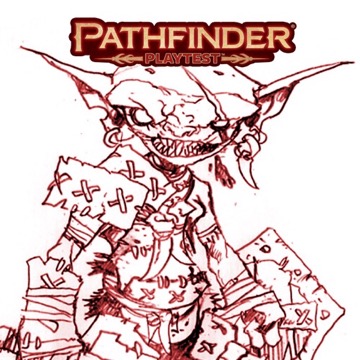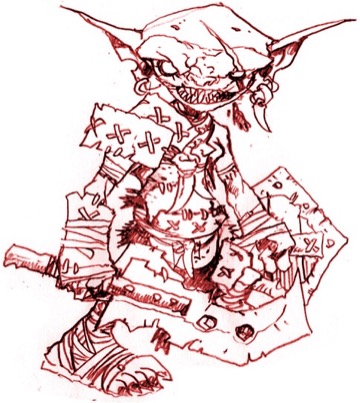Ever since the goblin song from page 12 of 2007's Pathfinder Adventure Path #1: Burnt Offerings, goblins have been a key part of what makes Pathfinder recognizable as Pathfinder. When we first started looking at what would become the ancestries in the Pathfinder Playtest Rulebook, we knew that we wanted to add something to the mix, to broaden the horizon of what it meant to be a hero in Pathfinder. That naturally brought us to goblins.
The trick was finding a way to let you play a goblin who has the feel of a Pathfinder goblin, but who is also a little bit softer around the edges—a character who has a reason to work with a group of "longshanks," as opposed to trying to light them on fire at the first opportunity. Let's look at an excerpt from the goblin ancestry to find out a bit more.
As a people, goblins have spent millennia feared, maligned, and even hunted—and sometimes for understandable reasons, as some rural goblin tribes still often direct cruelty, raiding, and mayhem toward wandering or vulnerable creatures. In recent decades, however, a new sort of hero has emerged from among these rough-and-tumble tribes. Such goblins bear the same oversized heads, pointed ears, red eyes, and jagged teeth of their crueler kin, but they have a noble or savvy streak that other goblins can't even imagine, let alone understand. These erstwhile heroes roam Golarion, often maintaining their distinctive cultural habits while spreading the enthusiasm, inscrutable quirkiness, love of puns and song, and unique mirth that mark goblin adventurers.
Despite breaking from their destructive past, goblin adventurers often subtly perpetuate some of the qualities that have been characteristics of the creatures for millennia. They tend to flock to strong leaders, and fiercely protect those companions who have protected them from physical harm or who offer a sympathetic ear and sage advice when they learn of the goblins' woes. Some goblins remain deeply fascinated with fire, or fearlessly devour meals that might turn others' stomachs. Others are inveterate tinkerers and view their companions' trash as components of gadgets yet to be made. Occasionally, fellow adventurers find these proclivities unsettling or odd, but more often than not goblins' friends consider these qualities endearing.
The entry in the Pathfinder Playtest Rulebook has plenty more to say on the topic, but that should give you a sense of where we are taking Pathfinder's favorite troublemakers.
In addition to the story behind the goblin, its ancestry entry has a lot of other information as well to help you make a goblin player character. It includes the base goblin ability boosts (Dexterity and Charisma), ability flaw (Wisdom), bonus Hit Points (6), base speed (25 feet), and starting languages (Common and Goblin), as well as the rules for darkvision (an ability that lets goblins see in the dark just as well as they can see in normal light). Those are just the basics—the rules shared by all goblins. Beyond that, your goblin's unique ancestry allows you to choose one ability score other than Dexterity or Charisma to receive a boost. Perhaps you have some hobgoblin blood and have an additional boost to Constitution, or you descend from a long line of goblin alchemists and have a boost to Intelligence. You could even gain a boost in Wisdom to negate your flaw!
Then you get into the goblin ancestry feats, which allow you to decide what type of goblin you want to play. Starting off, let's look at Burn It. This feat gives you a bonus to damage whenever you cast a fire spell or deal fire damage with an alchemical item. On top of that, it also increases any persistent fire damage you deal by 1. Goblins still love watching things burn.
Next up is one of my favorites, Junk Tinkerer. A goblin with this feat can craft ordinary items and weapons out of junk and scrap they can find almost anywhere. Sure, the items are of poor quality and break easily, but you will never be without a weapon if you have this feat.
We could not have goblins in the game without adding the Razor Teeth feat. This grants you an attack with your mouthful of razor-sharp teeth that deals 1d6 piercing damage. To be honest, the target of your attack should probably also attempt a Fortitude save against whatever you ate last night that is still stuck between your teeth, but we'll leave that for the GM to decide.
Finally, there is the appropriately named feat Very Sneaky. This lets you move 5 feet farther when you take an action to sneak (which normally lets you move at only half your normal speed) and potentially renders your target flat-footed against a follow-up strike!
There are plenty of other goblin feats for you to choose from, but that's all we have time for today. Come back on Friday when we'll look at some of the feats from the other ancestries in the game!
Jason Bulmahn
Director of Game Design








